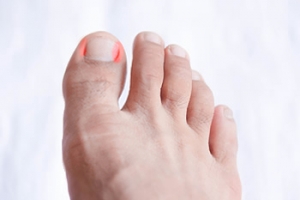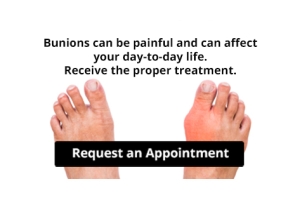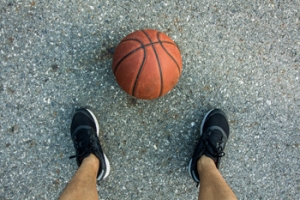
Sever's Disease
Sever's disease, also known as calcaneal apophysitis, is a medical condition that causes heel pain in children’s feet while they’re growing. Sever's disease occurs most commonly in boys and girls between the ages of 8 and 14.
Sever's disease occurs when the child’s growth plate, or the calcaneal epiphysis, an area attached to the Achilles tendon, is injured or when the muscles and tendons of the growing foot do not keep pace with bone growth. The result is constant pain experienced at the back of the heel and the inability to put any weight on the heel. This forces the child to bear weight on their toes while walking. When a toe gait develops, the child must change the way they walk to avoid placing weight on the painful heel. If this is not properly addressed, this can lead to further developmental problems.
The most common symptom of Sever's disease is acute pain felt in the heel when a child engages in physical activity such as walking, jumping or running. Children who are active athletes are among the group most susceptible to experiencing Sever's disease. This is due to the extreme stress and tension placed on their growing feet. The rolling movement of the foot during walking or running and obesity are both additional conditions linked to causing Sever's disease.
The first step in treating Sever's disease is to rest the foot and leg and avoid physical activity. Over the counter pain-relieving and anti-inflammatory medications can be helpful for reducing the amount of heel pain. A child with Sever's disease should also wear shoes that properly support the heel and the arch of the foot. Consider purchasing orthotic shoe inserts which can help support the heel and foot while it is healing. Most patients with Sever's disease symptoms report an eventual elimination of heel pain after wearing orthotic insoles that support the affected heel.
Sever's disease may affect either one heel or both. It is important for a child experiencing heel pain to be examined by a foot doctor who can apply the squeeze test. The squeeze test compresses both sides of the heel in order to determine if there is intense pain. Discourage any child diagnosed with Sever's disease from going barefoot as this can intensify the problem. Apply ice packs to the affected painful heel two or three times a day for pain relief.
Exercises that help stretch the calf muscles and hamstrings are effective at treating Sever's disease. An exercise known as foot curling has also proven to be very effective at treating Sever's disease. When foot curling, the foot is pointed away from the body, then curled toward the body to help stretch the muscles. The curling exercise should be done in sets of 10 or 20 repetitions and repeated several times throughout the day.
Treatment methods can continue for at least 2 weeks and as long as 2 months before the heel pain completely disappears. A child can continue doing daily stretching exercises for the legs and feet to prevent Sever’s disease from returning.
What Causes Heel Pain?
 Heel pain is a condition that many patients experience, and it may be caused due to a variety of reasons. The medical ailment that is known as plantar fasciitis is a common cause of heel pain, and can be extremely uncomfortable. Additionally, a tear or injury to the Achilles tendon may cause sharp pain that is felt in the calf and the heel. If an injury has occurred, moderate relief may be found when the foot is elevated, and the affected area is given rest as often as possible. For severe heel pain, it is strongly advised that you consult with a podiatrist as quickly as possible to determine the cause, and allow for proper treatment to begin.
Heel pain is a condition that many patients experience, and it may be caused due to a variety of reasons. The medical ailment that is known as plantar fasciitis is a common cause of heel pain, and can be extremely uncomfortable. Additionally, a tear or injury to the Achilles tendon may cause sharp pain that is felt in the calf and the heel. If an injury has occurred, moderate relief may be found when the foot is elevated, and the affected area is given rest as often as possible. For severe heel pain, it is strongly advised that you consult with a podiatrist as quickly as possible to determine the cause, and allow for proper treatment to begin.
Many people suffer from bouts of heel pain. For more information, contact Corinne R. Kauderer, DPM of Dyker Heights Foot & Ankle. Our doctor can provide the care you need to keep you pain-free and on your feet.
Causes of Heel Pain
Heel pain is often associated with plantar fasciitis. The plantar fascia is a band of tissues that extends along the bottom of the foot. A rip or tear in this ligament can cause inflammation of the tissue.
Achilles tendonitis is another cause of heel pain. Inflammation of the Achilles tendon will cause pain from fractures and muscle tearing. Lack of flexibility is also another symptom.
Heel spurs are another cause of pain. When the tissues of the plantar fascia undergo a great deal of stress, it can lead to ligament separation from the heel bone, causing heel spurs.
Why Might Heel Pain Occur?
- Wearing ill-fitting shoes
- Wearing non-supportive shoes
- Weight change
- Excessive running
Treatments
Heel pain should be treated as soon as possible for immediate results. Keeping your feet in a stress-free environment will help. If you suffer from Achilles tendonitis or plantar fasciitis, applying ice will reduce the swelling. Stretching before an exercise like running will help the muscles. Using all these tips will help make heel pain a condition of the past.
If you have any questions please contact one of our offices located in Brooklyn, NY and Old Bridge, NJ . We offer the newest diagnostic and treatment technologies for all your foot and ankle needs.
Heel Pain
Have you ever gotten up from a chair or out of bed in the morning, and upon taking that first step, feel like your heel has stepped on a tack? Many people experience a feeling of sharp pain which radiates into their arch from their heel and which does not allow them to put their heel on the floor. Sometimes they need to sit back down, stand only on their toes and use the wall for balance. If you can take a few steps, it seems to go away and lessen, allowing you to then resume your activity. Later, throughout your day and after a period of rest, it can happen again. If this sounds familiar you may be suffering from your first attack of heel pain.
Heel pain is a debilitating condition that affects day to day activities. Running and walking both causes stress on the heel because the heel is the part of the foot that hits the ground first. This means that the heel is taking on your entire weight. Diagnosis and treatments for heel pain can be easily found through your podiatrist.
Plantar Fasciitis
One of the main causes of heel pain is a condition known as plantar fasciitis. The plantar fascia is a band of tissue that extends along the bottom of the foot, from the toe to the bottom of the heel. A rip or tear in this ligament can cause inflammation of these tissues, resulting in heel pain. People who do not wear proper fitting shoes are often at risk of developing problems such as plantar fasciitis. Unnecessary stress from ill-fitting shoes, weight change, excessive running, and wearing non-supportive shoes on hard surfaces are all causes of plantar fasciitis.
Achilles Tendonitis
Achilles tendonitis is another cause of heel pain. Similar to plantar fasciitis, inflammation of the Achilles tendon will cause heel pain due to stress fractures and muscle tearing. A lack of flexibility of the ankle and heel is an indicator of Achilles tendonitis. If left untreated, this condition can lead to plantar fasciitis and cause even more pain on your heel.
Heel Spur
A third cause of heel pain is a heel spur. A heel spur occurs when the tissues of the plantar fascia undergo a great deal of stress, leading to a separation of the ligament from the heel bone entirely. This results in a pointed fragment of bone on the ball of the foot, known as a heel spur.
Avoid Developing an Ingrown Toenail
 As many patients know, having an ingrown toenail can be extremely painful, and can often make completing everyday activities more difficult. To help prevent developing this uncomfortable condition, it’s important that certain precautions are taken while cutting your toenails. The first step for proper trimming starts with your technique. Nails should be trimmed straight across, avoiding making them rounded. They should also be trimmed just enough that the corners loosely sit on the skin, and not too short where they begin to dig into the skin. You also want to make sure that the clippers you’re using to trim your nails are specifically designed for the purpose of trimming toenails. Some signs that may indicate you’ve developed an ingrown toenail can include redness surrounding the skin of the affected toe, swelling, pain, and in more severe cases, you may notice pus around the nail. In order to safely treat an ingrown toenail, we recommend you consult with a podiatrist for professional care and attention.
As many patients know, having an ingrown toenail can be extremely painful, and can often make completing everyday activities more difficult. To help prevent developing this uncomfortable condition, it’s important that certain precautions are taken while cutting your toenails. The first step for proper trimming starts with your technique. Nails should be trimmed straight across, avoiding making them rounded. They should also be trimmed just enough that the corners loosely sit on the skin, and not too short where they begin to dig into the skin. You also want to make sure that the clippers you’re using to trim your nails are specifically designed for the purpose of trimming toenails. Some signs that may indicate you’ve developed an ingrown toenail can include redness surrounding the skin of the affected toe, swelling, pain, and in more severe cases, you may notice pus around the nail. In order to safely treat an ingrown toenail, we recommend you consult with a podiatrist for professional care and attention.
Ingrown toenails may initially present themselves as a minor discomfort, but they may progress into an infection in the skin without proper treatment. For more information about ingrown toenails, contact Corinne R. Kauderer, DPM of Dyker Heights Foot & Ankle. Our doctor can provide the care you need to keep you pain-free and on your feet.
Ingrown Toenails
Ingrown toenails are caused when the corner or side of a toenail grows into the soft flesh surrounding it. They often result in redness, swelling, pain, and in some cases, infection. This condition typically affects the big toe and may recur if it is not treated properly.
Causes
- Improper toenail trimming
- Genetics
- Improper shoe fitting
- Injury from pedicures or nail picking
- Abnormal gait
- Poor hygiene
You are more likely to develop an ingrown toenail if you are obese, have diabetes, arthritis, or have any fungal infection in your nails. Additionally, people who have foot or toe deformities are at a higher risk of developing an ingrown toenail.
Symptoms
Some symptoms of ingrown toenails are redness, swelling, and pain. In rare cases, there may be a yellowish drainage coming from the nail.
Treatment
Ignoring an ingrown toenail can have serious complications. Infections of the nail border can progress to a deeper soft-tissue infection, which can then turn into a bone infection. You should always speak with your podiatrist if you suspect you have an ingrown toenail, especially if you have diabetes or poor circulation.
If you have any questions, please feel free to contact one of our offices located in Brooklyn, NY and Old Bridge, NJ . We offer the newest diagnostic and treatment technologies for all your foot care needs.
Ingrown Toenail Care
An ingrown toenail is a toenail that grows sideways into the nail bed, causing pain and swelling. Ingrown toenails can worsen and cause drainage, turning into a serious infection.
Several factors affect whether a person is at risk from an ingrown toenail. The many causes include being overweight, diabetes, participating in sports, having a fungal infection of the toe, and cutting your nails too short. Ingrown toenails also have a genetic predisposition, causing some people to be more prone to receive the condition than others. Other causes include improperly fitting shoes and shoes that keep the feet damp.
Ingrown toenails can be preventable with certain measures. For starters, allowing your toe nails to grow slightly longer in length will help prevent them from becoming ingrown. If you have already developed an ingrown toenail, soak the affected toe in warm water. This will alleviate the pain and help prevent an infection from forming. Antibiotic soap or Epsom salts may be added to further help the relieving process and avoid infection. Placing cotton beneath the affected area is also suggested, as this may help the toenail grow upwards and not into the nail bed. Swelling and redness can be reduced by resting with your feet elevated.
A podiatrist should be seen if the pain becomes so serious that it prevents you from doing your everyday activities. If a red streak running up your leg appears or if you suspect your infection has spread, contact a podiatrist immediately. Fast treatments can be undertaken to lessen your pain and have you walking comfortably.
An ingrown toenail can be easily treated with a Band-Aid. Simply wrap the affected toe with a Band-Aid to prevent infection and keep the nail from growing out at a painful angle.
In more serious cases, your podiatrist may decide to make a small incision to remove a portion of your toenail. To prevent the nail from growing back, medication will be placed directly into the nail bed. This procedure would be performed under local anesthesia and is a faster method to alleviate discomfort from an ingrown toenail. Post-procedure directions will have you stay off the affected foot for a day. Afterwards, normal activities can be resumed.
Massages Are a Form of Foot Therapy
 Many patients enjoy a specific type of foot therapy which is known as a massage. Research has indicated that massaging the feet may help to relax the body. An effective way to begin a foot massage is to perform warm up twists. This consists of placing the hands on both sides of the feet, and gently twisting back and forth. The bottom of the foot can feel better when arch rubs are performed. Flexibility may be improved with toe bends, in addition to spreading the toes, and squeezing the heel. If you would like additional information about the benefits of foot massages, please consult with a podiatrist.
Many patients enjoy a specific type of foot therapy which is known as a massage. Research has indicated that massaging the feet may help to relax the body. An effective way to begin a foot massage is to perform warm up twists. This consists of placing the hands on both sides of the feet, and gently twisting back and forth. The bottom of the foot can feel better when arch rubs are performed. Flexibility may be improved with toe bends, in addition to spreading the toes, and squeezing the heel. If you would like additional information about the benefits of foot massages, please consult with a podiatrist.
Foot therapy is often necessary for those recovering from either foot deformities or foot injuries. If you have concerns regarding therapy, consult with Corinne R. Kauderer, DPM from Dyker Heights Foot & Ankle. Our doctor can provide the care you need to keep you pain-free and on your feet.
Most Common Injuries
People who are active or athletes are prone to a variety of injuries. Therefore, it is often important to take part in physical therapy in order to quickly get back on the right track.
What to Do When Injured
Physical Therapy – This specialized treatment will focus on the affected area, speeding up recovery and the overall healing process. It is a proven method that has helped millions of people return from any injury.
During physical therapy you will undergo regimented training to get back into full form. Training is often very difficult, especially at first when the foot feels weak. Physical therapy often involves:
Basic stretching and twisting exercises – getting the feet’s mobility and flexibility up.
Massaging – the therapist will massage the injured area in order to activate the muscles and relax them.
Strengthening Exercises – this allows the muscles in the affected area to regain their full strength, a vital step towards full recovery.
If you have any questions please feel free to contact one of our offices located in Brooklyn, NY and Old Bridge, NJ . We offer the newest diagnostic tools and technology to treat your foot and ankle needs.
Foot Therapy for Sports Injuries
Foot Therapy for Sports Injuries
Athletes are used to engaging in high-intensity workouts. Consequently, athletes are at an increased risk for enduring foot or ankle injuries. The most common way to treat these types of injuries is the RICE method (Rest, Ice, Compression, and Elevation). However, braces and casts may be required in some cases. If you are suffering from any of these injuries, it is best that you seek help from your podiatrist right away.
Achilles Tendinitis
Achilles tendinitis is a type of overuse injury of the Achilles tendon, which is the tendon connecting the calf muscles to the heel. This type of injury commonly occurs in runners who increase the intensity of their workouts. Symptoms for this condition start off as a mild ache in the back leg or above the heel. Some people experience tenderness around the area in the morning, however this feeling tends to improve over time. If you suspect you have Achilles tendinitis, you doctor may order an x-ray to show whether your Achilles tendon has calcified. Common treatment options for this condition include rest, ice, exercise, and non-steroidal anti-inflammatory medication.
Plantar Fasciitis
Plantar Fasciitis is a condition that is commonly found in women. It is a painful condition that occurs when the bands of tissue that connect the heel to the toes become inflamed. Symptoms for plantar fasciitis are heel pain that worsens in the morning and improves throughout the day with activity. Your podiatrist will diagnose plantar fasciitis by checking for tender areas on your foot. In rare cases, an x-ray may be required for a more thorough examination. There are various treatment options that may be used to help someone with this ailment. Depending on the specific case, some of these options include: physical therapy, shockwave therapy, and in rare cases, surgery.
Stress Fractures
Stress fractures are tiny cracks in the bone that occur due to repetitive force. These fractures are typically the result of overuse injuries such as repeatedly running and jumping. Symptoms of a stress fracture include pain when exercising, tenderness, and mild swelling. To diagnose a stress fracture, your doctor will likely ask you a series of questions about your overall health and the activities you are involved in. Next, an x-ray will likely be performed to check for the fracture. In some cases, fractures don’t appear on x-rays until weeks afterward. In these cases, an MRI or a bone scan may be required. Typical stress fractures may be treated by resting the area and taking a break from highly intense activities.
Ankle Sprain
Ankle sprains occur when the ligaments that support the ankle are stretched far beyond their limits. These injuries occur when you roll, twist, or turn your ankle in an awkward way. Ligaments are essential in helping us move around because they are responsible for stabilizing the joints. Usually, sprained ankles occur due to ligaments on the outer part of the ankle becoming stretched. Symptoms of ankle sprains are swelling, bruising, instability of the ankle, and restricted range of motion. Normally, when people sprain their ankle, they will hear a popping sound during the injury. Depending on the severity, ankle sprains are graded based on how much damage has occurred to the ligaments. Grade 1 is mild, grade 2 is moderate, and grade 3 is severe.
Are Bunions Affecting Your Everyday Life?
Ankle Injury Happens To Maverick Guard Luka Doncic
 Luka Doncic is a guard for the Dallas Mavericks and had to miss the game that was played against the Bucks after he sprained his ankle. The injury happened during the game against Miami, and the Mavericks lost during overtime with a score of 122-118. His injury was a significant factor in losing points for the team. The injury occurred when his right foot landed on the foot of another player. This is the first game he has currently not been able to play in, and has missed ten games in his rookie season as a result of minor injuries.
Luka Doncic is a guard for the Dallas Mavericks and had to miss the game that was played against the Bucks after he sprained his ankle. The injury happened during the game against Miami, and the Mavericks lost during overtime with a score of 122-118. His injury was a significant factor in losing points for the team. The injury occurred when his right foot landed on the foot of another player. This is the first game he has currently not been able to play in, and has missed ten games in his rookie season as a result of minor injuries.
Sports related foot and ankle injuries require proper treatment before players can go back to their regular routines. For more information, contact Corinne R. Kauderer, DPM of Dyker Heights Foot & Ankle. Our doctor can provide the care you need to keep you pain-free and on your feet.
Sports Related Foot and Ankle Injuries
Foot and ankle injuries are a common occurrence when it comes to athletes of any sport. While many athletes dismiss the initial aches and pains, the truth is that ignoring potential foot and ankle injuries can lead to serious problems. As athletes continue to place pressure and strain the area further, a mild injury can turn into something as serious as a rupture and may lead to a permanent disability. There are many factors that contribute to sports related foot and ankle injuries, which include failure to warm up properly, not providing support or wearing bad footwear. Common injuries and conditions athletes face, including:
- Plantar Fasciitis
- Plantar Fasciosis
- Achilles Tendinitis
- Achilles Tendon Rupture
- Ankle Sprains
Sports related injuries are commonly treated using the RICE method. This includes rest, applying ice to the injured area, compression and elevating the ankle. More serious sprains and injuries may require surgery, which could include arthroscopic and reconstructive surgery. Rehabilitation and therapy may also be required in order to get any recovering athlete to become fully functional again. Any unusual aches and pains an athlete sustains must be evaluated by a licensed, reputable medical professional.
If you have any questions please feel free to contact one of our offices located in Brooklyn, NY and Old Bridge, NJ . We offer the newest diagnostic and treatment technologies for all your foot and ankle needs.















